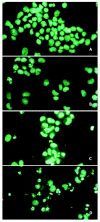Effects of hydroxyapatite nanoparticles on proliferation and apoptosis of human hepatoma BEL-7402 cells
- PMID: 12970886
- PMCID: PMC4656654
- DOI: 10.3748/wjg.v9.i9.1968
Effects of hydroxyapatite nanoparticles on proliferation and apoptosis of human hepatoma BEL-7402 cells
Abstract
Aim: To study the effect of hydroxyapatite (HAP) nanoparticles on human hepatoma cell line BEL-7402 in vitro.
Methods: The human hepatoma cell line BEL-7402 was cultured and treated with HAP nanoparticles at various concentrations. Growth suppression was detected with MTT colorimetric assay, cell apoptotic alterations were evaluated by cytochemical staining (Hoechst 33258), transmission electron microscopy (TEM), and flow cytometry (FCM).
Results: HAP nanoparticles inhibited the growth of hepatoma cells in a dose-dependent manner, with IC(50) values of 29.30 mg/L. Treated with 50-200 mg/L HAP nanoparticles for 48 h, BEL-7402 cells apoptosis with nuclear chromatin condensation and fragmentation as well as cell shrinkage and the formation of apoptotic bodies were observed under cytochemical staining and transmission electron microscopy. FCM analysis showed hypodiploid peaks on histogram, the apoptotic rates at the concentrations of 50, 75, 100, 150 and 200 mg/L of HAP nanoparticles were 20.35+/-2.23 %, 25.35+/-1.92 %, 29.34+/-4.61 %, 44.92+/-3.78 % and 53.64+/-3.49 %, respectively, which were all significantly higher than that of control group 2.23+/-0.14 %. There was a significant correlation between HAP nanoparticle concentration and apoptotic rate (r=0.994, P<0.01).
Conclusion: HAP nanoparticles not only inhibit proliferation but also induce apoptosis of human hepatoma cell line BEL-7402 in vitro.
Figures
Similar articles
-
Growth inhibition and apoptosis induction in human hepatoma cells by tanshinone II A.J Huazhong Univ Sci Technolog Med Sci. 2003;23(2):166-8, 172. doi: 10.1007/BF02859946. J Huazhong Univ Sci Technolog Med Sci. 2003. PMID: 12973939
-
Effect of hydroxyapatite nanoparticles on the ultrastructure and function of hepatocellular carcinoma cells in vitro.Biomed Mater. 2006 Mar;1(1):38-41. doi: 10.1088/1748-6041/1/1/006. Epub 2006 Mar 15. Biomed Mater. 2006. PMID: 18458384
-
[Effect of tanshinone IIA on the growth behavior of human hepatoma cell line BEL-7402 in vitro and its mechanism].Di Yi Jun Yi Da Xue Xue Bao. 2003 Jun;23(6):595-7, 601. Di Yi Jun Yi Da Xue Xue Bao. 2003. PMID: 12810386 Chinese.
-
Antineoplastic mechanism of Octreotide action in human hepatoma.Chin Med J (Engl). 2001 Nov;114(11):1167-70. Chin Med J (Engl). 2001. PMID: 11729512
-
γ-terpineol inhibits cell growth and induces apoptosis in human liver cancer BEL-7402 cells in vitro.Int J Clin Exp Pathol. 2014 Sep 15;7(10):6524-33. eCollection 2014. Int J Clin Exp Pathol. 2014. PMID: 25400730 Free PMC article.
Cited by
-
3D Microfluidic Bone Tumor Microenvironment Comprised of Hydroxyapatite/Fibrin Composite.Front Bioeng Biotechnol. 2019 Jul 17;7:168. doi: 10.3389/fbioe.2019.00168. eCollection 2019. Front Bioeng Biotechnol. 2019. PMID: 31380359 Free PMC article.
-
The inhibition of lamellar hydroxyapatite and lamellar magnetic hydroxyapatite on the migration and adhesion of breast cancer cells.J Mater Sci Mater Med. 2014 Apr;25(4):1025-31. doi: 10.1007/s10856-013-5126-8. Epub 2013 Dec 21. J Mater Sci Mater Med. 2014. PMID: 24363068
-
Characteristics of functionalized nano-hydroxyapatite and internalization by human epithelial cell.Nanoscale Res Lett. 2011 Nov 23;6(1):600. doi: 10.1186/1556-276X-6-600. Nanoscale Res Lett. 2011. PMID: 22108000 Free PMC article.
-
Anti-hepatoma effect of safrole from Cinnamomum longepaniculatum leaf essential oil in vitro.Int J Clin Exp Pathol. 2014 Apr 15;7(5):2265-72. eCollection 2014. Int J Clin Exp Pathol. 2014. PMID: 24966935 Free PMC article.
-
Effect of hydroxyapatite nanoparticles on the growth and p53/c-Myc protein expression of implanted hepatic VX2 tumor in rabbits by intravenous injection.World J Gastroenterol. 2007 May 28;13(20):2798-802. doi: 10.3748/wjg.v13.i20.2798. World J Gastroenterol. 2007. PMID: 17569114 Free PMC article.
References
MeSH terms
Substances
LinkOut - more resources
Full Text Sources
Other Literature Sources
Medical



